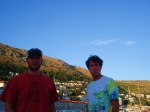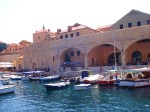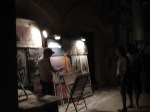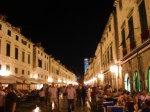This summer, Jack Taylor, Wes Fleming, and I planned an impromptu trip to Bosnia while looking at a map of the Balkans in Croatia. We figured it would be an interesting experience, and we were definitely right. The trek originally mapped out a two and a half hour bus ride to Ploce, Croatia. From there, we would get on a train and head northeast to Mostar, Bosnia.
Ploce’s train station is basically a mind trip. Tickets are still written out by hand. No computer or anything, just a lady sitting at a desk with a pen and some paper. The train had a wooden interior. We quickly noticed that is was donated from Sweden to help replace the trains that were destroyed in the Bosnian War in the 1990’s. All the windows were stuck upright, and it was easily pushing 95-100 degrees on this hot July day.
After about an hour on the train, I realized that I didn’t have my passport zipped securely in my pocket. Wes and Jack walked to the front of the train and had their passports checked by the Bosnian customs official. They reached the rear of the train before he did and informed me to get my passport out. When the guard came to where I was standing, he walked right by me. Why did he do this, you ask? Wes and I both had baseball hats on, so we definitely stood out from the other few train passengers. When he came back, it was just Jack and I in the last car. Since he had already checked two American passports, he never bothered to check mine because Wes was not in our car. He thought I was Wes. By the time he walked by, I was sweating…part because of the heat…and part because I was wondering what would happen when he realized I was entering Bosnia with no passport.
As the train continued to roll into Bosnia, none of us had a good feeling. It is never good to lose a passport, but illegally crossing a border is another story. The prospects of getting my passport back were also grim. U.S. passports are known to fetch up to $1,000-$5,000 street value in both Eastern Europe. While we continued slowly, through winding mountains and tunnels, I made a static filled satellite call to the U.S. embassy in Sarajevo. The guy on the other end could not really believe what I was telling him. He kept saying, “that’s impossible,” when I said I was actually in the country. He kept asking, “where is your passport again?” I would respond, “it’s in Croatia, but I’m in Bosnia now.” Again he would reply, “that’s impossible.”
Our plans changed quick. We needed to get to Sarajevo ASAP. I also needed to keep a low profile. That night at the hostel, I avoided writing my passport number down when asked. Trains to Sarajevo left at 6AM and 6PM. We arrived at the capital around 10AM. The ride was beautiful. A picturesque river ran next to the tracks for the majority of the ride. After leaving the train station, we got some vague directions to the embassy. It was easy to spot when we finally got into the right area. It featured a large white building with guards in front carrying automatic weapons. I showed them my South Carolina drivers license and was let in through the front gate.
After going through several metal detectors, and a brief questioning, I got the call to approach a teller window. Here, I began telling the story. On the bus ride in Croatia, we had to stop on two separate occasions for passport checks by customs officials. After the second check, I remember reading the introduction section of my passport and then I set it down on the seat next to me. Since the bus made several stops, it was hard to figure out exactly what towns we were stopping in because there were no signs or announcements. When we reached Ploce, we had to grab our rucksacks and quickly get off to avoid missing our stop. Of course, my passport continued down the winding Croatian highway on an old bus that hugged the cliffs to avoid dropping into the sea below.
I had to tell the story three times. The final account was told to about twenty embassy officials who crowded around the glass divider which resembled an arena ticket office. One official laughed as he said, “people try and tunnel in and get caught, and you just came right in on a train.” Most trains that we rode in the Balkans had two or often three passport checks. So having one, and getting by, was unbelievably lucky.
My passport eventually was located. I had given the bus company name to the embassy over the phone. They were able to track it down. Two girls from England who were sitting behind us on the bus turned it in. While my train was rolling into Bosnia, the U.S. embassy sent an official…I assume by car, to get my passport on the Croatian side of the border. In Sarajevo, we were six hours into Bosnia by train. We had to get back to Dubrovnik to fly out in approximately thirty hours. So, for the time being, they monitored where we were staying. We rented a Bosnian man’s upstairs apartment for the night, and I returned to the embassy the following day. If the passport didn’t make it back in time, the embassy would have to consider a few different options for getting us out by air. I am not sure if we would have left on a military plane or what.
As I made the three mile walk back to the embassy the following afternoon, past bullet riddled buildings and street vendors, I still had one question in mind. The passport had just arrived, which was great, but what would have happened to me if I had gotten caught entering the country illegally? An embassy worker explained, “they would have stopped the train, arrested you immediately, and brought you back to the Croatian border where you would have been held in dual custody, with one phone call.”














